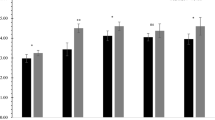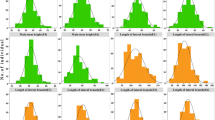Abstract
Scoring for lodging resistance is difficult under natural field conditions. The stem strength of wheat has been used as an index of lodging resistance. However, this is a complex trait comprised of two characters, i.e. stem mechanical elasticity and rigidity. Therefore it is closely associated with stem morphological and anatomical features. A study of the genetics of stem strength and related traits of basal stem internodes is very important for genetic improvement of lodging resistance in wheat. In this study, a doubled-haploid (DH) population derived from anther culture of the cross CA9613/H1488 was used. Stem strength and related basal internode traits were measured at the milk stage. A molecular map of the DH population was constructed using 189 SSR markers, and quantitative trait loci (QTL) for each trait were analyzed based on this molecular linkage map. A total of six QTL for stem strength, culm wall thickness, pith diameter and stem diameter were identified: 1) Two QTL (QSs-3A and QSs-3B) for stem strength were detected on chromosomes 3A and 3B, exhibiting 10.6 and 16.6% phenotypic variance, respectively. 2) Two QTL (QPd-1A and QPd-2D) associated with pith diameter were detected on chromosomes 1A and 2D, respectively, jointly explaining about 30% of phenotypic variance. 3) As far as stem diameter and culm wall thickness were concerned, one QTL was detected on chromosomes 3B and 2D, respectively; QSd-3B explained 8.7% of the phenotypic variance of stem diameter, whereas QCwt-2D explained 9.6% of the phenotypic variance of culm wall thickness. In addition, among the QTLs detected, two with pleiotropic effects were observed. Correlated traits are usually associated with the pleiotropic effects of the same QTL(s) or linkage of different QTLs. But this was not true in some cases. The results of QTL mapping showed that stem strength can be improved by breeding for wider stems with a higher stem diameter/pith diameter ratio. This can be facilitated by using the markers linked to QSd-3B and QCwt-2D. Combining stem strength, stem diameter and culm wall thickness may be used as a selection index for lodging resistance with marker-assisted selection (MAS) to improve lodging resistance in this population.
Similar content being viewed by others
Abbreviations
- CIM:
-
composite interval mapping
- CWT:
-
culm wall thickness of basal internode
- DH:
-
doubled-haploid population
- LOD:
-
log10 likelihood value
- MAS:
-
marker-assisted selection
- PCR:
-
polymerase chain reaction
- PD:
-
pith diameter of basal internode
- RILs:
-
recombinant inbred lines
- QTL:
-
quantitative trait loci
- SD:
-
stem diameter of basal internode
- SS:
-
stem strength
- SSR:
-
simple sequence repeat
References
AI-Qaudhy, W., R. Morris & R.F. Mumm, 1988 Chromosome locations of genes for traits associated with lodging on winter wheat. Crop Sci 28: 631–635.
Atkins, I.M. 1938 Relation of certain plant characters to strength of straw and lodging in winter wheat. J Agric Res 56: 99–120.
Bao, J.S., Y.R. Wu, B. Hu, P. Wu, H.R. Cui & Q.Y. Shu, 2002 QTL for grain quality based on a DH population derived from parents with similar apparent amylose content. Euphytica 128: 317–324.
Bassam, B.J., G. Caetano-Anolles & P.M. Gressoff, 1991 Fast and sensitive silver staining of DNA in polyacrylamid gels. Anal Biochem 196: 80–83.
Basten, J.C., B.S. Weir & Z.B. Zeng, 1997 QTL Cartographer. A Reference Manual and Tutorial for QTL Mapping. Department of Statistics, North Carolina State University, Raleigh, NC.
Berry, P.M., J.M. Griffin, R. Sylvester-Bradley, R.K. Scott, J.H. Spink, C.J. Baker & R.W. Clare, 2000 Controlling plant form through husbandry to minimize lodging in wheat. Field Crops Res 67: 51–58.
Dunn, G.J. & K.G. Briggs, 1989 Variation in culm anatomy among barley genotypes differing in lodging resistance. Can J Bot 67: 1838–1843.
Easson, D.L., E.M. White & S.L. Pickles, 1993 The effects of weather, seed rate and genotype on lodging and yield in winter wheat. J Agri Sci (Camb) 121: 145–156.
Holland, J.B., H.S. Moser, L.S. O’Donoughue & M. Lee, 1997 QTLs and epistasis association with vernalization responses in oat. Crop Sci 37: 1306–1316.
Huang, Y.L. 1988 Morphological factors and control techniques of lodging in wheat. Jiangsu Agric Sci 10: 5–8.
Ishimaru, K., K. Shirota, M. Higa & Y. Kawamitsu, 2001 Identification of quantitative trait loci for adaxial and abaxial stomatal frequencies in Oryza sativa. Plant Physiol Biochem 39: 173–177.
Jellum, M.D. 1962 Relationships between lodging resistance and certain culm characters in oats. Crop Sci 2: 263–267.
Kashiwagi, T. & K. Ishimaru, 2004 Identification and functional analysis of a locus for improvement of lodging resistance in rice. Plant Physiol 134: 676–683.
Kato, K., H. Miura & S. Sawada, 2000 Mapping QTLs controlling grain yield and its components on chromosome 5A of wheat. Theor Appl Genet 101: 1114–1121.
Kelbert, A.J., D. Spaner, K.G. Briggs & J.R. King, 2004 The association of culm anatomy with lodging susceptibility in modern spring wheat genotypes. Euphytica 136: 211–221.
Keller, M., C.H. Karutz, J.E.Schmid, P.Stamo, M.Winzeler, B.Keller, M.M.Messmer. 1999. Quantitative trait loci for lodging resistance in a segregating wheat × spelt population. Theor Appl Genet 98: 1171–1182.
Kohli, S.P., K.K.Mukherjee, K.L.Sethi. 1970. Interitance of characters associated with lodging in a wheat cross. Indian J Genet Plant Breed 30: 431–438.
Kosambi, D.D. 1944 The estamation of map distances from recombination values. Ann. Eugen. 12: 172–175.
Lander, E.S., D. Bostein, 1989 Mapping Mendelian factors underlying quantitative traits using RFLP linkage maps. Genetics 121: 185–199.
Lander, E.S., P. Green, J. Abrahamson, A. Barlow, M.J. Daly, S.E. Lincoln & L. Newburg, 1987 Mapmaker: An interactive computer package for constructing primary genetic linkage maps of experimental and natural populations. Genomics 1: 174–181.
Li, Q.Q. 1998 Creation, Evaluation and Utilization of Winter Wheat Germplasm, pp. 203–219. Shangdong Science and Technology Press, Jinan.
Lin, H.X., H.R. Qian, J.Y. Zhuang, J. Lu, S.K. Min, Z.M. Xiong, N. Huang & K.L. Zheng, 1996 RFLP mapping of QTLs for yield and related characters in rice (Oryza sativa L.), Theor Appl Genet 92: 920–927.
Luthra, O.P., R.S. Paroda & R.B. Srivastava, 1981 Combining ability of characters related to lodging in wheat. Indian J Agric Sci 51: 367–371.
Malkani, J.J. & S.M. Vaidga, 1956 Morphological characters of shoot and root in relation to lodging in three wheat cultivars. India J Genet Plant Breed 16: 121–133.
Matsuzaki, A., S. Matsushima, T. Tomita & E. Katsuki, 1972 Analysis of yield-determining process and its application to yield-production and culture improvement of lowland rice. CIX. Effects of nitrogen top-dressing at full heading stage on lodging resistance, root activity, yield and kernel quality. Jpn J Crop Sci 41: 139–146.
Min, D.H. 2001 Studies on the lodging resistance with its subtraits of different height wheat varieties and correlation between plant height and yield. J Triticeae Crops 21(4): 76–79.
Mulder, E.G. 1954 Effect of mineral nutrition on lodging of cereals. Plant Soil 5: 246–306.
Mukherjee, K.K., S.P. Kohli & K.L. Sethi, 1967 Lodging resistance in wheat. Indian J Agron 12: 56–61.
Pinthus, M.J. 1967 Spread of the root system as an indicator for evaluating lodging resistance of wheat. Crop Sci 7: 107–111.
Pinthus, M.L. 1973 Lodging in wheat, barley, and oats: The phenomenon, its causes, and preventative measures. Adv Agron 25: 210–256.
Pu, D.F., J.R. Zhou, B.F. Li, Q. Li & Q. Zhou, 2000 Evaluation method of root lodging resistance in wheat. Acta Agri Breali-Occidentalis Sinica 9: 58–61.
Qi, X., R.E. Niks, P. Stam & P. Lindhout, 1998 Identification of QTL for partial resistance to leaf rust (Puccinia hordei) in barley. Theor Appl Genet 96: 1205–1215.
Röder, M.S., V. Korzun, K. Wendehake, J. Plaschke, M. Tixier, P. Leroy & M.W. Ganal, 1998 A microsatellite map of wheat. Genetics 149: 2007–2023.
SAS Institute, 1988 SAS procedure guide for personal computers release 6.03. SAS Institute. Cary, North Carolina, USA.
Sato, K. 1957 Studies on the starch contained in the tissues of rice plant: IV. Starch content in the culm related to lodging. Jpn J Crop Sci 26(1): 19.
Shevchuk, N.S. 1981 Inheritance of quantitative characters of lodging resistance in winter durum wheat hybrids. In: 4-1 S”ezd genetikov i selektsionerov Ukrainy, Odessa. Tez. Dokl. 3 kiev, Ukrainian SSR, pp. 66–68.
Tanksley, S.D. 1993 Mapping polygenes. Annu Rev Genet 27: 205–233.
Taylor, N.G., W.-R. Scheible, S. Cutler, C.R. Somerville & S.R. Turner, 1999 The irregular xylem 3 locus of Arabidiopsis encodes a cellulose synthase required for secondary cell wall synthesis. Plant Cell 11: 769–779.
Terashima, K., S. Akita & N. Sakai, 1992 Eco-physiological characteristics related with lodging tolerance of rice in direct sowing cultivation. I. Comparison of the root lodging tolerance among cultivars by the measurement of pushing resistance. Jpn J Crop Sci 61: 380–387.
Wang, Y. & Q.Q. Li, 1995 Study on the evaluation method of lodging resistance in wheat. Acta Agronomica Boreall-Sinica 10(3): 84–88.
Wang, Y. & C.H. Li, 1996 Advances in the study of wheat lodging resistance. J Shangdong Agric Univ 27(4): 503–508.
Wang, Y., Q.Q. Li, C.H. Li & A.H. Li, 1998 Studies on the culm quality and anatomy of wheat varieties. Acta Agronomica Sinica 24: 452–458.
Worland, T. & J.W. Snape, 2001 Genetic control of plant stature. In: A.P. Bonjean & W.J. Angus (Eds.), The World Wheat Book: A History of Wheat Breeding, pp: 67–71. Lavoisier Publishing, Paris, France.
Xiao, S.H., X.Y. Zhang, C.S. Yan, W.X. Zhang, L. Hai & H.J. Guo, 2002 Determination of resistance to lodging by stem strength in wheat. Agric Sci Chin 35(1): 7–11.
Xing, Y.Z., Y.F. Tan, J.P. Hua, X.L. Sun, C.G. Xu & Q. Zhang, 2002 Characterization of the main effects, epistastic effects and their environmental interactions of QTLs on the genetic basis of yield traits in rice. Theor Appl Genet 105: 248–257.
Yamagishi, M., Y. Takeuchi, Y. Kono & M. Yano, 2002 QTL analysis for panicle characteristics in temperate japonica rice. Euphytica 128: 219–224.
Yang, J., J. Zhang, Z. Wang & Q. Zhu, 2001 Activited of starch hydrolytic enzymes and sucrose-phosphate synthase in the stems of rice subjected to water stress during grain filling. J Exp Bot 52: 2169–2179.
Zeng, Z.B. 1994 Precision mapping of quantitative trait loci. Genetics 136: 1457–1468.
Zuber, U., H. Winzeler, M.M. Messmer, M. Keller, B. Keller, J.E. Schmid & P. Stamp, 1999 Morphological traits associated with lodging resistance of spring wheat (Triticum aestivum L.). J Agron Crop Sci 182: 17–24.
Author information
Authors and Affiliations
Corresponding author
Rights and permissions
About this article
Cite this article
Hai, L., Guo, H., Xiao, S. et al. Quantitative trait loci (QTL) of stem strength and related traits in a doubled-haploid population of wheat (Triticum aestivum L.). Euphytica 141, 1–9 (2005). https://doi.org/10.1007/s10681-005-4713-2
Received:
Accepted:
Issue Date:
DOI: https://doi.org/10.1007/s10681-005-4713-2




